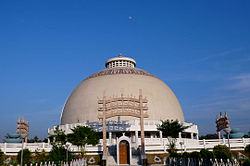Deekshabhoomi
| Deekshabhoomi | |
|---|---|
 Deekshabhoomi |
|
| Data | |
| place | Nagpur, Maharashtra, India |
| architect | Sheo Dan Mal |
| Construction year | 1978 |
| Coordinates | 21 ° 7 '41.4 " N , 79 ° 4' 1" E |
Deekshabhoomi or Dikshabhumi is a sacred building of Buddhism . It was built on the site where Babasaheb Ambedkar converted to Buddhism on October 14, 1956 with his approximately 380,000 followers. Ambedkar's conversion to Buddhism is still a model for the Indian people.
Deekshabhoomi is located in Nagpur in the state of Maharashtra , a place of pilgrimage for Buddhism in India. Thousands of pilgrims visit Deekshabhoomi every year, especially on Ashok Vijaya Dashmi and on October 14th. A large stupa was built on the site.
Deeksha literally means acceptance of religion. Deeksha in Buddhism corresponds to baptism in Christianity. Bhoomi means land. So Deekshabhoomi literally means "the land where people are converted to Buddhism". Deekshabhoomi is one of the two most important places in Ambedkar's life, the other is Chaityabhoomi in Mumbai .
Deekshabhoomi is famous for its architectural beauty and historical importance. It is also one of the most important tourist centers in India.
history
Ambedkar had already declared in 1935 that although he was born a Hindu , he would not die as such. After this declaration, he studied the teachings of all major religions extensively and then chose Buddhism for himself and his followers.
He selected Nagpur for the ceremony because it was the home of the Nag , a people who embraced Buddhism and supported it at great expense in its early days. On October 14, 1956, Ambedkar and his wife, Savita Ambedkar, took the Oath of the Three Gems and the Five Silas from Mahasthavir Chandramani. Ambedkar then handed the oath of the three jewels, the five silas and 22 vows to his thousands of followers.
Ambedkar died on December 6, 1956, just 6 weeks after the ceremony. After his death, the Dr. Ambedkar Smarak Samiti established to administer Deekshabhoomi. The committee decided to erect a stupa on the site as a memorial to the ceremony and the conversion of such a crowd to Buddhism.
architecture
Building history
The Deekshabhoomi stupa was designed by the famous architect Sheo Dan Mal . Construction of the stupa started in July 1978, but it took a long time to complete. Sagar Enterprise of Mumbai completed the structural work. The stupa was opened to the public on December 18, 2001 after an official inauguration by the Indian President KR Narayanan .
Stupa
The design of the stupa in Deekshabhoomi is based on the architecture of the world-famous Sanchi stupa . Unlike the Sanchi stupa, the Deekshabhoomi stupa is completely hollow inside. It is the largest cantilever Buddhist stupa in the world. On the ground floor there is a 64 × 64 meter square hall. In the middle of this hall is a statue of Buddha . This was donated by Thai students from Nagpur University. There is also a library and a photo exhibition with pictures from the lives of Gautama Buddha and Ambedkar.
The dome is located above the hall. A veranda runs around the dome. There is a fountain on all four sides of the dome. Marble from Dholpur, Rajasthan was used for the floors of the stupa . There are doors on all four sides of the stupa. The doors open in large arches adorned with Ashok chakras and statues of horses, elephants and lions that give it an ancient look.
There is a garden around the stupa that is maintained by the Nagpur Improvement Trust. In front of the stupa are statues of Ambedkar and Gautama Buddha.
Vihar and the poplar fig
Right in front of the stupa is a Buddha Vihara with a bronze Buddha figure. There are also facilities for the monks who live there.
Next to the vihara is a poplar fig , a sacred fig tree. This poplar fig is grown from three branches of the poplar figs from Anuradhapuram in Sri Lanka that were planted in Deekshabhoomi. Bhadant Anand Kausalyayan brought these branches with him from Sri Lanka in memory of Buddha's enlightenment.
tourism
Deekshabhoomi is visited by thousands of local and foreign tourists every year, mainly on the anniversary of the conversion ceremony. Most of the foreign tourists come from Buddhist countries such as Japan and Thailand .
Web links
Individual evidence
- ↑ Ambedkar's own illustration from a letter to Devapriya Valishinha dated October 30, 1956. The Maha Bodhi Vol. 65, p.226, quoted in Dr. Ambedkar and Buddhism (PDF; 569 kB) by Sangharakshita .
- ^ Life of Babasaheb (Web). Retrieved January 6, 2009.
- ↑ francis Pritchett: In the 1950 (Web) Columbia.edu. Retrieved January 6, 2009.
- ↑ Untouchables hug Buddha to escape oppression
- ↑ Frances Pritchett: In the 1930s . Retrieved October 28, 2017.
- ↑ His famous speech Mukti kon Pathe? (like: Which road to liberation?) in Mumbai, 1936.
- ↑ Frances Pritchett: Why Was Nagpur Chosen? . Retrieved October 28, 2017.
- ↑ The architect of the Dr Ambedkar Memorial Sheo Dan Mal has passed away (web) OneIndia. January 25, 2007. Retrieved January 5, 2009.
- ^ President KR Narayanan: Selected Speeches ISBN 81-230-1159-8
- ↑ Page 175, Modernization of Buddhism: Contribution of Ambedkar and Dalai Lama XIV By Lella Karunyakara ISBN 81-212-0813-0
- ↑ Thousands visit Deekshabhoomi in Nagpur (web) The Hindu . December 7, 2006. Retrieved July 5, 2008.
- Special edition of Lokrajya, a publication of the Govt. from Maharashtra for the silver jubilee of the 1956 ceremony
- Deeksha, special edition of the Daily Sakaal from October 2005
